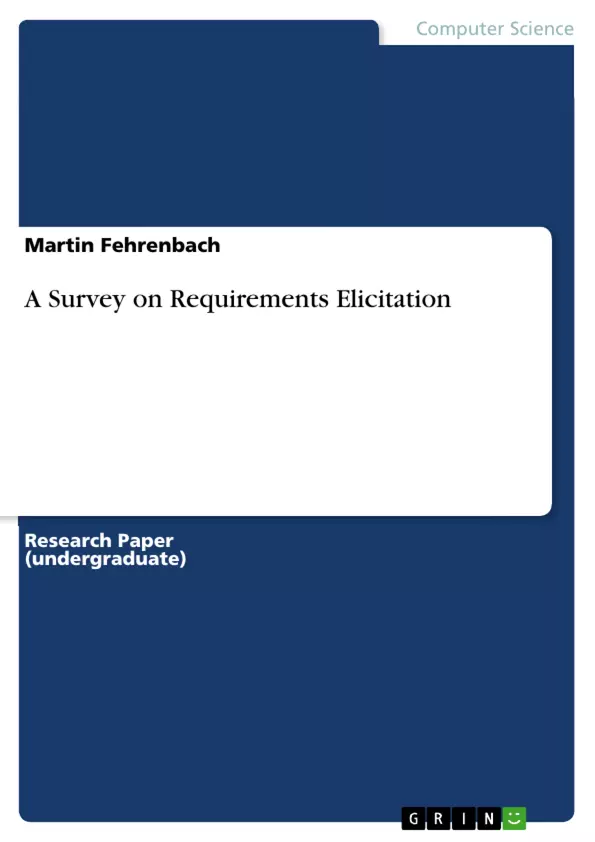The first step during the software development, requirements engineering, is very critical because of the high effort (in time and costs) that has to be made to correct mistakes detected later that have been made in this early phase of software life-cycle. In order to support the aim of high-quality software, the goals of requirements engineering are developing a complete as possible specification, providing integrated representation formalisms
and accomplishing a common agreement on the specification.
The very first activity that has to be passed through is requirements elicitation. There are existing three main problems: the problem of defining the scope, the problem of understanding
the users’ needs and the problem of requirements volatility over time. You can follow several heuristics and guidelines to find solutions to these problems. In addition, several techniques and methodologies have been suggested to support the process of
requirements elicitation. They differ in several ways: the kind of problem they intend to solve, the methods used for achieving this aim, the kind of people involved, the level of abstraction and precision the requirements have to be formulated in.
In this report, a selection of these techniques and methodologies is chosen and they are classified into a classification scheme worked out. The techniques and methodologies can coarsely be divided into four classes: interview-oriented approaches, objective and
goal analysis-oriented approaches, viewpoint analysis-oriented approaches, and scenario analysis-oriented approaches. There are others that do not fit into this division, but provide nevertheless help for requirements elicitation. The developed classification
scheme highlights the differences between the existing techniques. It should serve as an overview of existing techniques and methods as a guideline for analysts and developers for finding an appropriate method for problems at hand.
Table of Contents
- 1. Introduction
- 2. Conceptions and Guidelines
- 2.1 Requirements Elicitation Process Model
- 2.2 Guidelines for Requirements Elicitation
- 3. Framework for Understanding Elicitation Approaches
- 3.1 Problem
- 3.2 Methods
- 3.3 People
- 3.4 Type
- 3.5 Solution
- 4. Categorization of Requirements Elicitation Approaches
- 4.1 Interview-Oriented Approaches
- 4.2 Objective and Goal-Oriented Approaches
- 4.3 Viewpoint Analysis-Oriented Approaches
- 4.4 Scenario Analysis-Oriented Approaches
- 4.5 Others
- 5. Related work and Further Readings
- 6. Conclusions
Objectives and Key Themes
This thesis aims to provide a comprehensive overview of requirements elicitation techniques and methodologies, highlighting their differences and suitability for different scenarios. It explores existing problems, guidelines, and frameworks for understanding and categorizing these approaches.
- Challenges in requirements elicitation: Scope definition, understanding user needs, and requirements volatility.
- Guidelines and heuristics for addressing requirements elicitation challenges.
- Classification of requirements elicitation techniques and methodologies.
- Analysis of various approaches: Interview-oriented, objective and goal-oriented, viewpoint analysis-oriented, and scenario analysis-oriented.
- Framework for choosing appropriate elicitation methods based on project needs.
Chapter Summaries
- Chapter 1: Introduction - Introduces the critical role of requirements engineering in software development, emphasizing the need for accurate and complete specifications. It highlights the importance of requirements elicitation as the initial step and discusses its key challenges.
- Chapter 2: Conceptions and Guidelines - Presents a process model for requirements elicitation, outlining key steps and activities. It also offers practical guidelines for effectively addressing the challenges of scope definition, understanding user needs, and managing requirements volatility.
- Chapter 3: Framework for Understanding Elicitation Approaches - Introduces a framework for classifying and understanding various requirements elicitation techniques. This framework considers factors such as the type of problem addressed, methods employed, individuals involved, abstraction levels, and desired precision.
- Chapter 4: Categorization of Requirements Elicitation Approaches - Delves into a detailed categorization of requirements elicitation techniques, focusing on four main categories: interview-oriented, objective and goal-oriented, viewpoint analysis-oriented, and scenario analysis-oriented approaches. It also explores other techniques that don't fit neatly into these categories.
- Chapter 5: Related work and Further Readings - Provides a review of relevant literature and research on requirements elicitation, highlighting key findings and further areas of exploration.
Keywords
This thesis focuses on the crucial topic of requirements elicitation in software engineering. It examines various techniques and methodologies for eliciting requirements, exploring their strengths, weaknesses, and suitability for different scenarios. Key terms include requirements engineering, elicitation approaches, classification, interview-oriented, objective and goal-oriented, viewpoint analysis-oriented, scenario analysis-oriented, and framework.
- Citar trabajo
- Martin Fehrenbach (Autor), 1998, A Survey on Requirements Elicitation, Múnich, GRIN Verlag, https://www.grin.com/document/185271



